System Engineering Design: Glen Canyon Dam Construction Analysis
VerifiedAdded on 2020/03/16
|10
|2551
|156
Report
AI Summary
This report provides a critical analysis of the system engineering design process involved in dam construction, using the Glen Canyon Dam as a primary case study. It meticulously examines the different stages of design, from the preliminary phase, which involves defining project requirements and conceptual design, to detailed design and development, encompassing project management and technical architecture. The report delves into system testing, evaluation, validation, and optimization, emphasizing the importance of technical and environmental assessments, as well as the role of human factors. The ADDIE model is applied to the Glen Canyon Dam project, breaking down the construction process into analysis, design, development, implementation, and evaluation phases. The report also highlights the significance of continuous research and innovative thinking in addressing challenges in dam construction and the preservation of water resources. The conclusion emphasizes the importance of meticulous attention to detail and the societal benefits of dam construction.
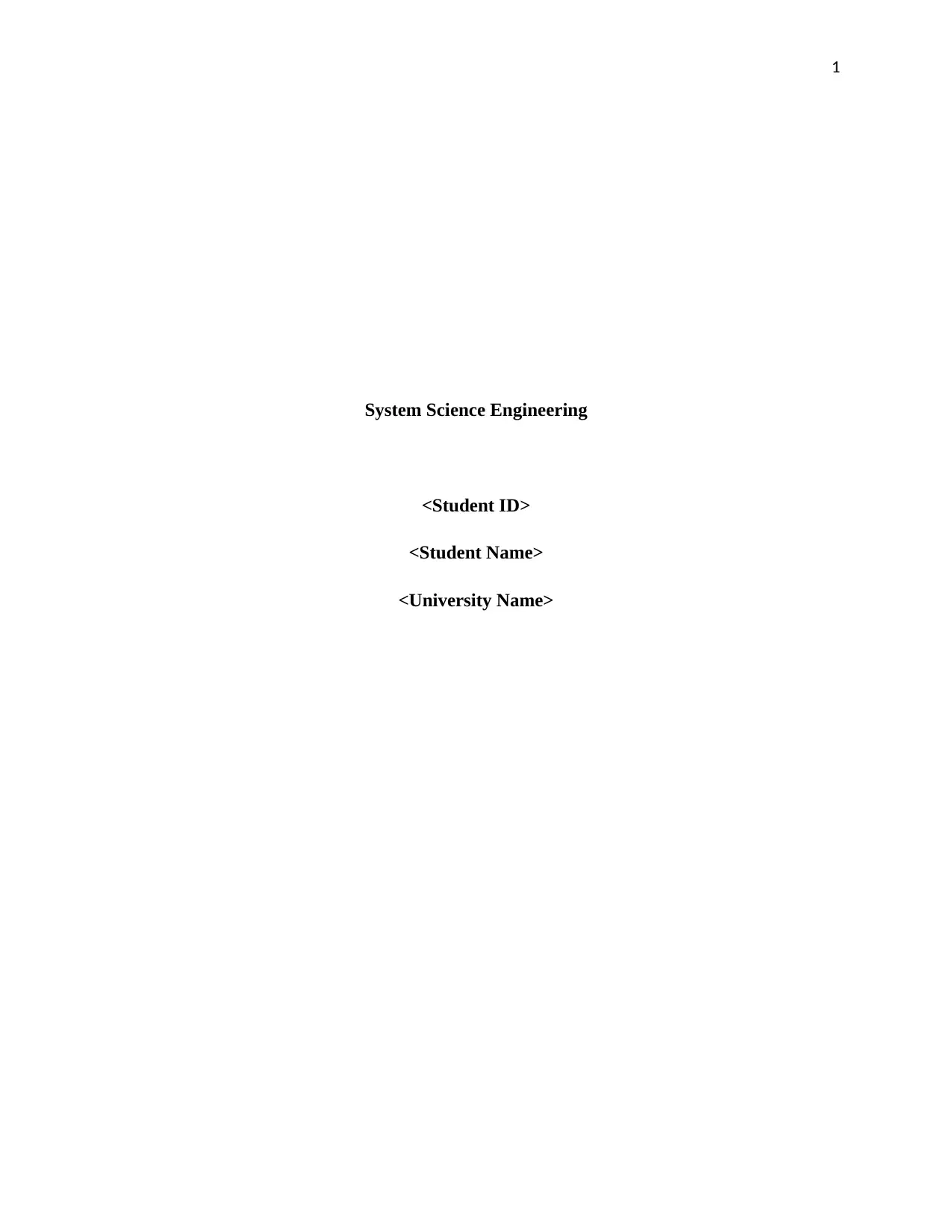
1
System Science Engineering
<Student ID>
<Student Name>
<University Name>
System Science Engineering
<Student ID>
<Student Name>
<University Name>
Paraphrase This Document
Need a fresh take? Get an instant paraphrase of this document with our AI Paraphraser

2
Executive Summary
The paper depicts the critical analysis of the system engineering design of the construction of a
dam. The assignment deals with the various stages of processes of design in the construction of
dams. The use of the concepts and models for the enhanced comprehension of the subject has
also been demonstrated.
Executive Summary
The paper depicts the critical analysis of the system engineering design of the construction of a
dam. The assignment deals with the various stages of processes of design in the construction of
dams. The use of the concepts and models for the enhanced comprehension of the subject has
also been demonstrated.
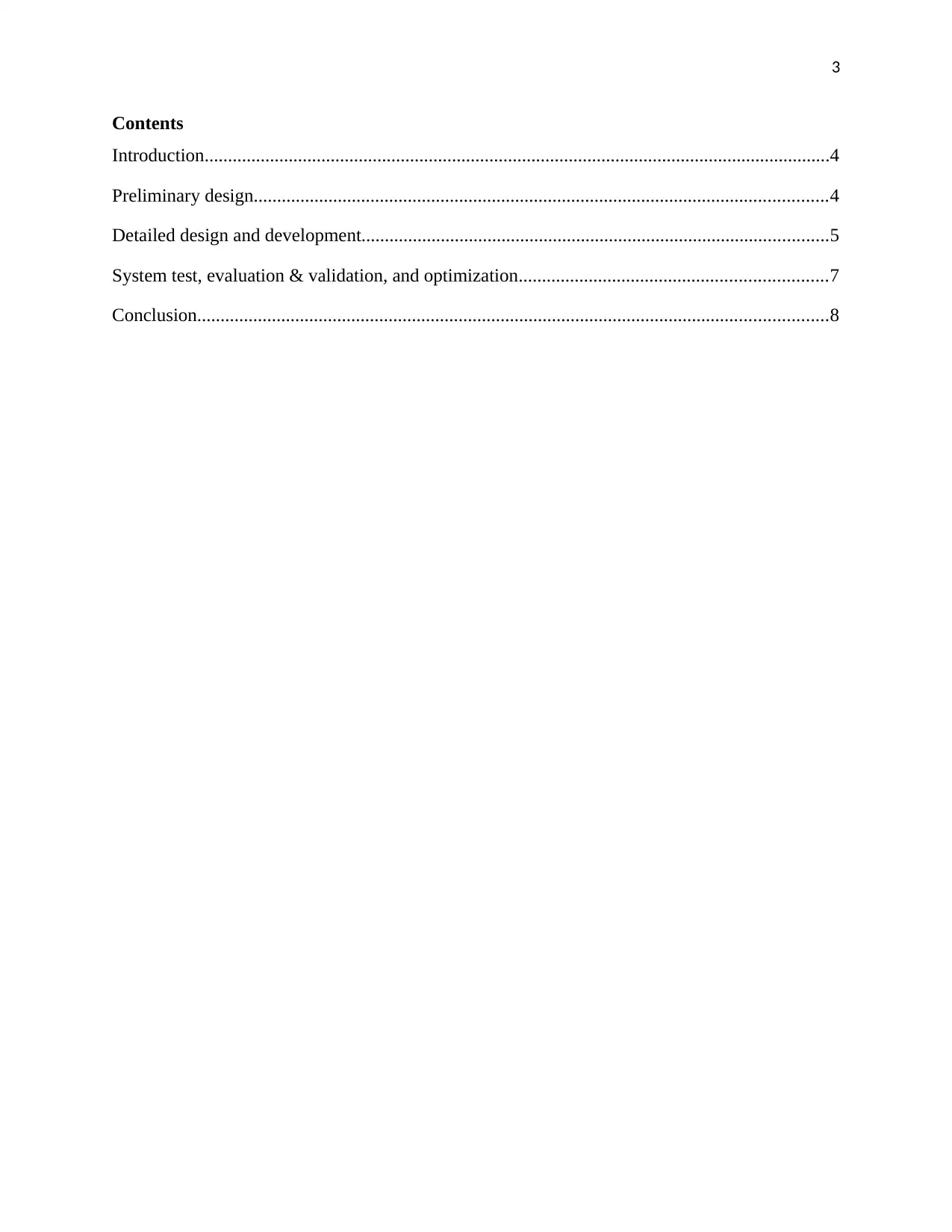
3
Contents
Introduction......................................................................................................................................4
Preliminary design...........................................................................................................................4
Detailed design and development....................................................................................................5
System test, evaluation & validation, and optimization..................................................................7
Conclusion.......................................................................................................................................8
Contents
Introduction......................................................................................................................................4
Preliminary design...........................................................................................................................4
Detailed design and development....................................................................................................5
System test, evaluation & validation, and optimization..................................................................7
Conclusion.......................................................................................................................................8
⊘ This is a preview!⊘
Do you want full access?
Subscribe today to unlock all pages.

Trusted by 1+ million students worldwide
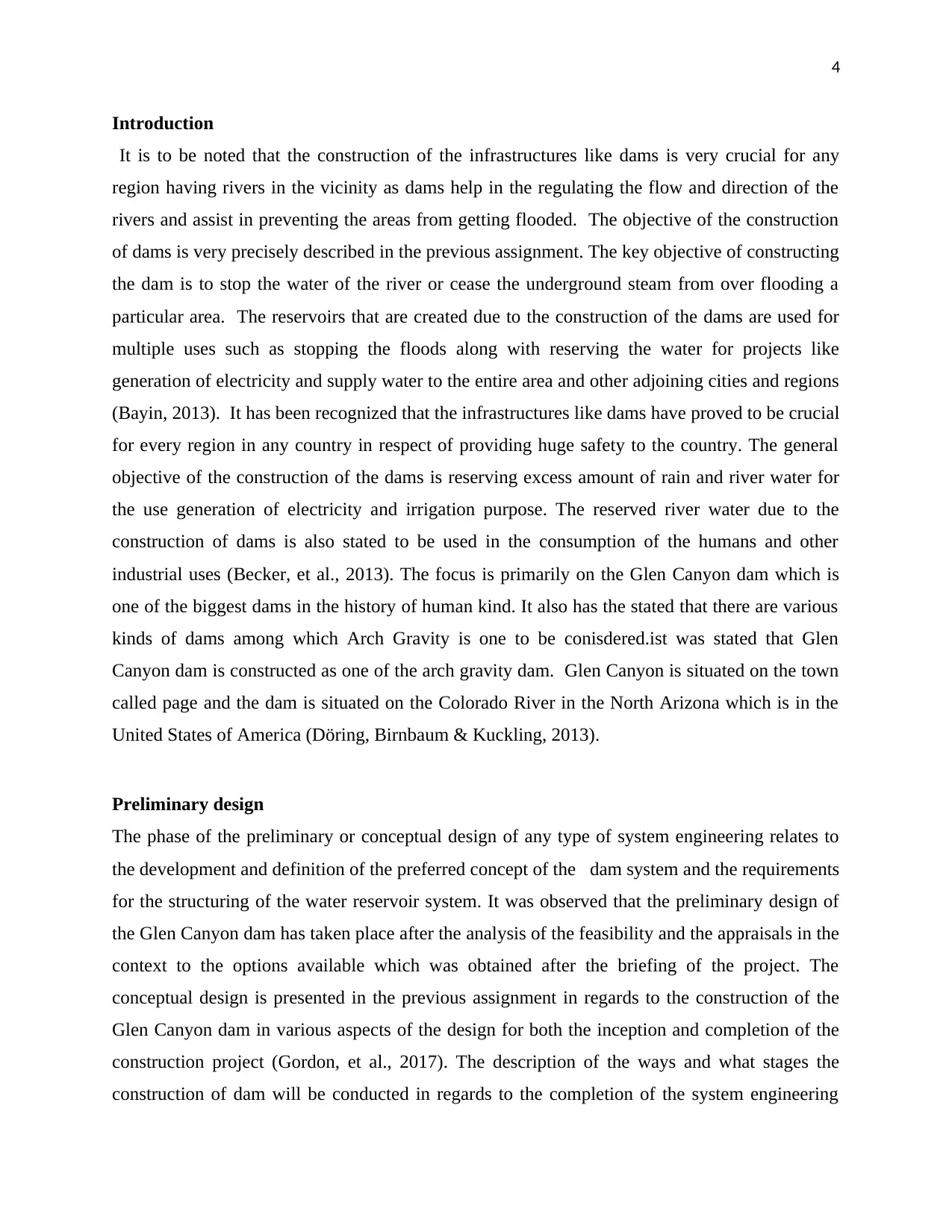
4
Introduction
It is to be noted that the construction of the infrastructures like dams is very crucial for any
region having rivers in the vicinity as dams help in the regulating the flow and direction of the
rivers and assist in preventing the areas from getting flooded. The objective of the construction
of dams is very precisely described in the previous assignment. The key objective of constructing
the dam is to stop the water of the river or cease the underground steam from over flooding a
particular area. The reservoirs that are created due to the construction of the dams are used for
multiple uses such as stopping the floods along with reserving the water for projects like
generation of electricity and supply water to the entire area and other adjoining cities and regions
(Bayin, 2013). It has been recognized that the infrastructures like dams have proved to be crucial
for every region in any country in respect of providing huge safety to the country. The general
objective of the construction of the dams is reserving excess amount of rain and river water for
the use generation of electricity and irrigation purpose. The reserved river water due to the
construction of dams is also stated to be used in the consumption of the humans and other
industrial uses (Becker, et al., 2013). The focus is primarily on the Glen Canyon dam which is
one of the biggest dams in the history of human kind. It also has the stated that there are various
kinds of dams among which Arch Gravity is one to be conisdered.ist was stated that Glen
Canyon dam is constructed as one of the arch gravity dam. Glen Canyon is situated on the town
called page and the dam is situated on the Colorado River in the North Arizona which is in the
United States of America (Döring, Birnbaum & Kuckling, 2013).
Preliminary design
The phase of the preliminary or conceptual design of any type of system engineering relates to
the development and definition of the preferred concept of the dam system and the requirements
for the structuring of the water reservoir system. It was observed that the preliminary design of
the Glen Canyon dam has taken place after the analysis of the feasibility and the appraisals in the
context to the options available which was obtained after the briefing of the project. The
conceptual design is presented in the previous assignment in regards to the construction of the
Glen Canyon dam in various aspects of the design for both the inception and completion of the
construction project (Gordon, et al., 2017). The description of the ways and what stages the
construction of dam will be conducted in regards to the completion of the system engineering
Introduction
It is to be noted that the construction of the infrastructures like dams is very crucial for any
region having rivers in the vicinity as dams help in the regulating the flow and direction of the
rivers and assist in preventing the areas from getting flooded. The objective of the construction
of dams is very precisely described in the previous assignment. The key objective of constructing
the dam is to stop the water of the river or cease the underground steam from over flooding a
particular area. The reservoirs that are created due to the construction of the dams are used for
multiple uses such as stopping the floods along with reserving the water for projects like
generation of electricity and supply water to the entire area and other adjoining cities and regions
(Bayin, 2013). It has been recognized that the infrastructures like dams have proved to be crucial
for every region in any country in respect of providing huge safety to the country. The general
objective of the construction of the dams is reserving excess amount of rain and river water for
the use generation of electricity and irrigation purpose. The reserved river water due to the
construction of dams is also stated to be used in the consumption of the humans and other
industrial uses (Becker, et al., 2013). The focus is primarily on the Glen Canyon dam which is
one of the biggest dams in the history of human kind. It also has the stated that there are various
kinds of dams among which Arch Gravity is one to be conisdered.ist was stated that Glen
Canyon dam is constructed as one of the arch gravity dam. Glen Canyon is situated on the town
called page and the dam is situated on the Colorado River in the North Arizona which is in the
United States of America (Döring, Birnbaum & Kuckling, 2013).
Preliminary design
The phase of the preliminary or conceptual design of any type of system engineering relates to
the development and definition of the preferred concept of the dam system and the requirements
for the structuring of the water reservoir system. It was observed that the preliminary design of
the Glen Canyon dam has taken place after the analysis of the feasibility and the appraisals in the
context to the options available which was obtained after the briefing of the project. The
conceptual design is presented in the previous assignment in regards to the construction of the
Glen Canyon dam in various aspects of the design for both the inception and completion of the
construction project (Gordon, et al., 2017). The description of the ways and what stages the
construction of dam will be conducted in regards to the completion of the system engineering
Paraphrase This Document
Need a fresh take? Get an instant paraphrase of this document with our AI Paraphraser
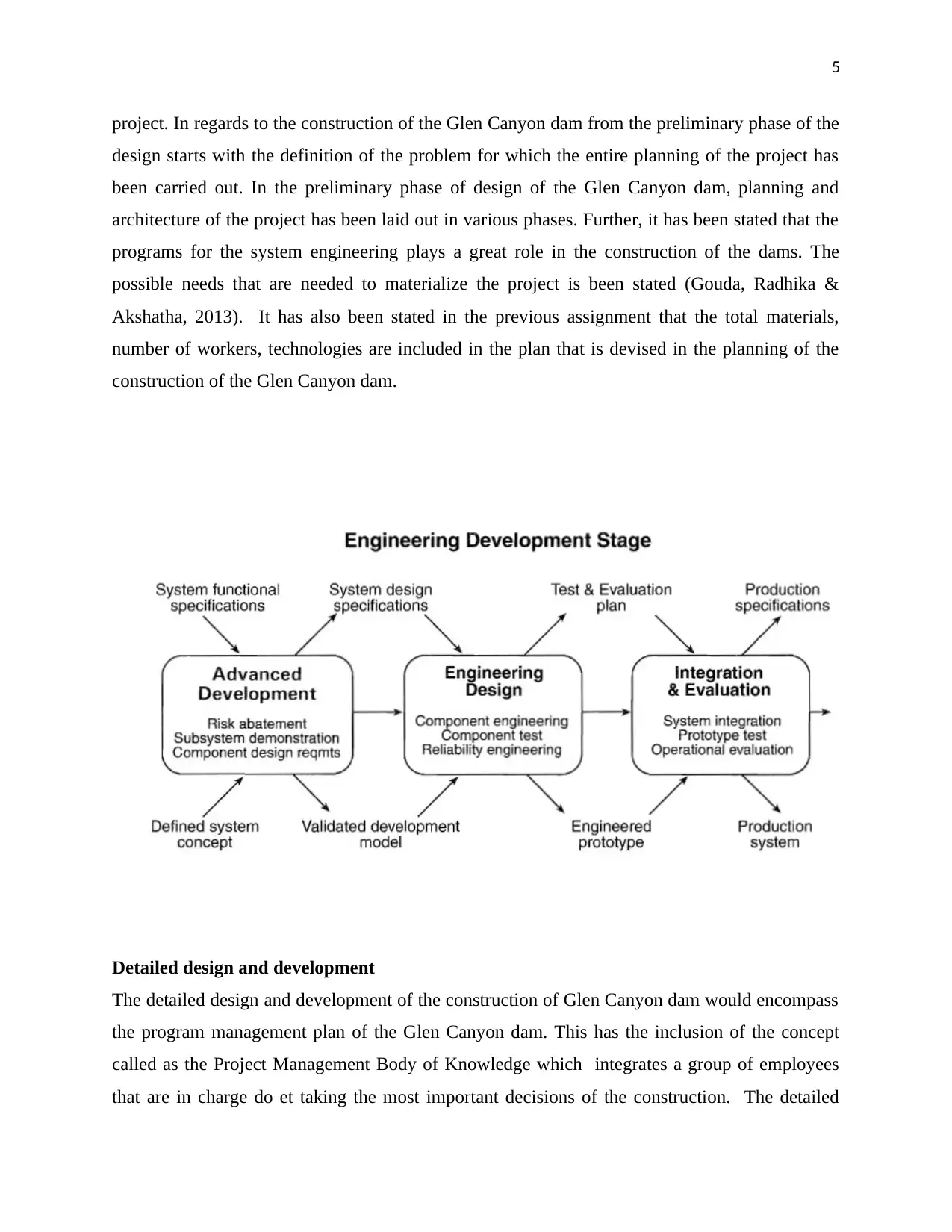
5
project. In regards to the construction of the Glen Canyon dam from the preliminary phase of the
design starts with the definition of the problem for which the entire planning of the project has
been carried out. In the preliminary phase of design of the Glen Canyon dam, planning and
architecture of the project has been laid out in various phases. Further, it has been stated that the
programs for the system engineering plays a great role in the construction of the dams. The
possible needs that are needed to materialize the project is been stated (Gouda, Radhika &
Akshatha, 2013). It has also been stated in the previous assignment that the total materials,
number of workers, technologies are included in the plan that is devised in the planning of the
construction of the Glen Canyon dam.
Detailed design and development
The detailed design and development of the construction of Glen Canyon dam would encompass
the program management plan of the Glen Canyon dam. This has the inclusion of the concept
called as the Project Management Body of Knowledge which integrates a group of employees
that are in charge do et taking the most important decisions of the construction. The detailed
project. In regards to the construction of the Glen Canyon dam from the preliminary phase of the
design starts with the definition of the problem for which the entire planning of the project has
been carried out. In the preliminary phase of design of the Glen Canyon dam, planning and
architecture of the project has been laid out in various phases. Further, it has been stated that the
programs for the system engineering plays a great role in the construction of the dams. The
possible needs that are needed to materialize the project is been stated (Gouda, Radhika &
Akshatha, 2013). It has also been stated in the previous assignment that the total materials,
number of workers, technologies are included in the plan that is devised in the planning of the
construction of the Glen Canyon dam.
Detailed design and development
The detailed design and development of the construction of Glen Canyon dam would encompass
the program management plan of the Glen Canyon dam. This has the inclusion of the concept
called as the Project Management Body of Knowledge which integrates a group of employees
that are in charge do et taking the most important decisions of the construction. The detailed
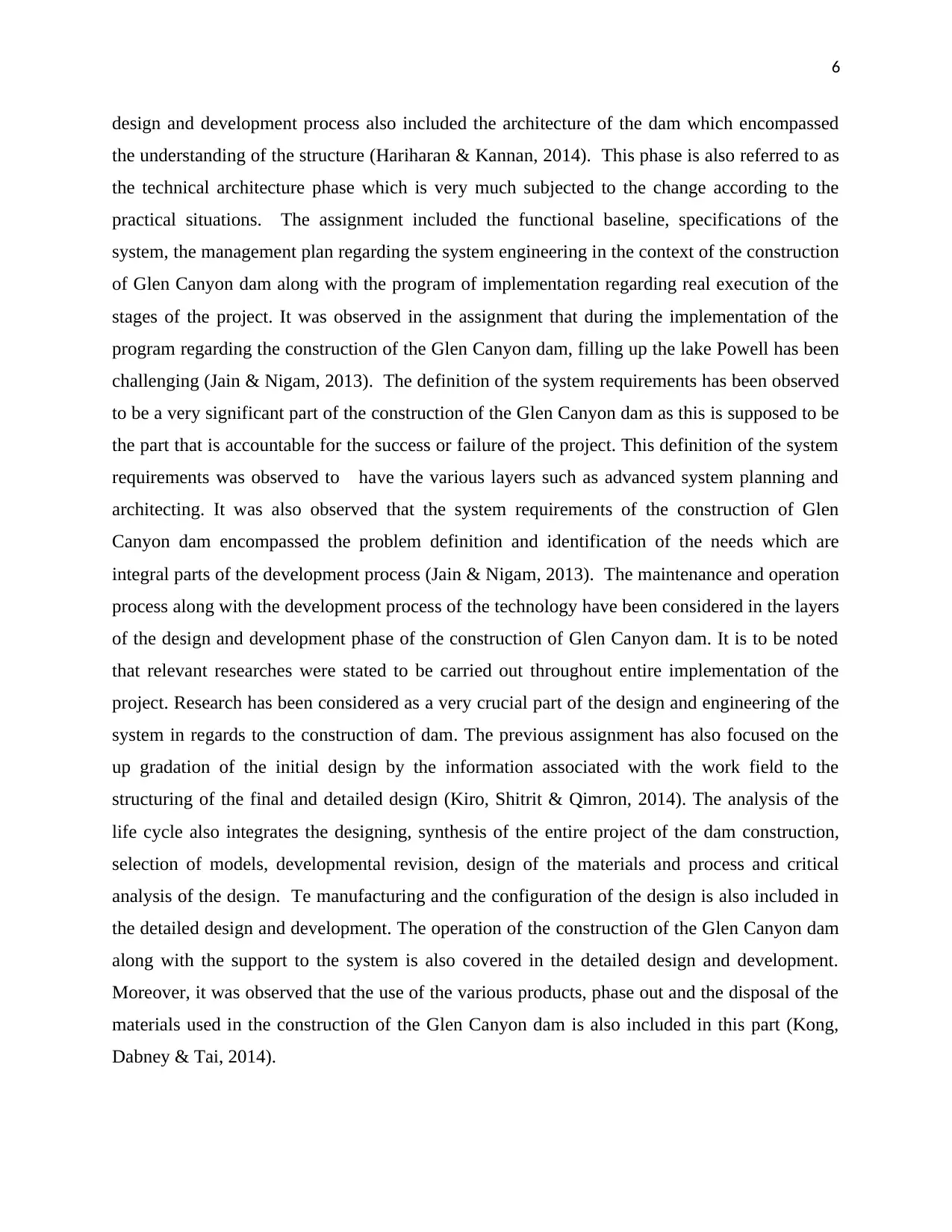
6
design and development process also included the architecture of the dam which encompassed
the understanding of the structure (Hariharan & Kannan, 2014). This phase is also referred to as
the technical architecture phase which is very much subjected to the change according to the
practical situations. The assignment included the functional baseline, specifications of the
system, the management plan regarding the system engineering in the context of the construction
of Glen Canyon dam along with the program of implementation regarding real execution of the
stages of the project. It was observed in the assignment that during the implementation of the
program regarding the construction of the Glen Canyon dam, filling up the lake Powell has been
challenging (Jain & Nigam, 2013). The definition of the system requirements has been observed
to be a very significant part of the construction of the Glen Canyon dam as this is supposed to be
the part that is accountable for the success or failure of the project. This definition of the system
requirements was observed to have the various layers such as advanced system planning and
architecting. It was also observed that the system requirements of the construction of Glen
Canyon dam encompassed the problem definition and identification of the needs which are
integral parts of the development process (Jain & Nigam, 2013). The maintenance and operation
process along with the development process of the technology have been considered in the layers
of the design and development phase of the construction of Glen Canyon dam. It is to be noted
that relevant researches were stated to be carried out throughout entire implementation of the
project. Research has been considered as a very crucial part of the design and engineering of the
system in regards to the construction of dam. The previous assignment has also focused on the
up gradation of the initial design by the information associated with the work field to the
structuring of the final and detailed design (Kiro, Shitrit & Qimron, 2014). The analysis of the
life cycle also integrates the designing, synthesis of the entire project of the dam construction,
selection of models, developmental revision, design of the materials and process and critical
analysis of the design. Te manufacturing and the configuration of the design is also included in
the detailed design and development. The operation of the construction of the Glen Canyon dam
along with the support to the system is also covered in the detailed design and development.
Moreover, it was observed that the use of the various products, phase out and the disposal of the
materials used in the construction of the Glen Canyon dam is also included in this part (Kong,
Dabney & Tai, 2014).
design and development process also included the architecture of the dam which encompassed
the understanding of the structure (Hariharan & Kannan, 2014). This phase is also referred to as
the technical architecture phase which is very much subjected to the change according to the
practical situations. The assignment included the functional baseline, specifications of the
system, the management plan regarding the system engineering in the context of the construction
of Glen Canyon dam along with the program of implementation regarding real execution of the
stages of the project. It was observed in the assignment that during the implementation of the
program regarding the construction of the Glen Canyon dam, filling up the lake Powell has been
challenging (Jain & Nigam, 2013). The definition of the system requirements has been observed
to be a very significant part of the construction of the Glen Canyon dam as this is supposed to be
the part that is accountable for the success or failure of the project. This definition of the system
requirements was observed to have the various layers such as advanced system planning and
architecting. It was also observed that the system requirements of the construction of Glen
Canyon dam encompassed the problem definition and identification of the needs which are
integral parts of the development process (Jain & Nigam, 2013). The maintenance and operation
process along with the development process of the technology have been considered in the layers
of the design and development phase of the construction of Glen Canyon dam. It is to be noted
that relevant researches were stated to be carried out throughout entire implementation of the
project. Research has been considered as a very crucial part of the design and engineering of the
system in regards to the construction of dam. The previous assignment has also focused on the
up gradation of the initial design by the information associated with the work field to the
structuring of the final and detailed design (Kiro, Shitrit & Qimron, 2014). The analysis of the
life cycle also integrates the designing, synthesis of the entire project of the dam construction,
selection of models, developmental revision, design of the materials and process and critical
analysis of the design. Te manufacturing and the configuration of the design is also included in
the detailed design and development. The operation of the construction of the Glen Canyon dam
along with the support to the system is also covered in the detailed design and development.
Moreover, it was observed that the use of the various products, phase out and the disposal of the
materials used in the construction of the Glen Canyon dam is also included in this part (Kong,
Dabney & Tai, 2014).
⊘ This is a preview!⊘
Do you want full access?
Subscribe today to unlock all pages.

Trusted by 1+ million students worldwide
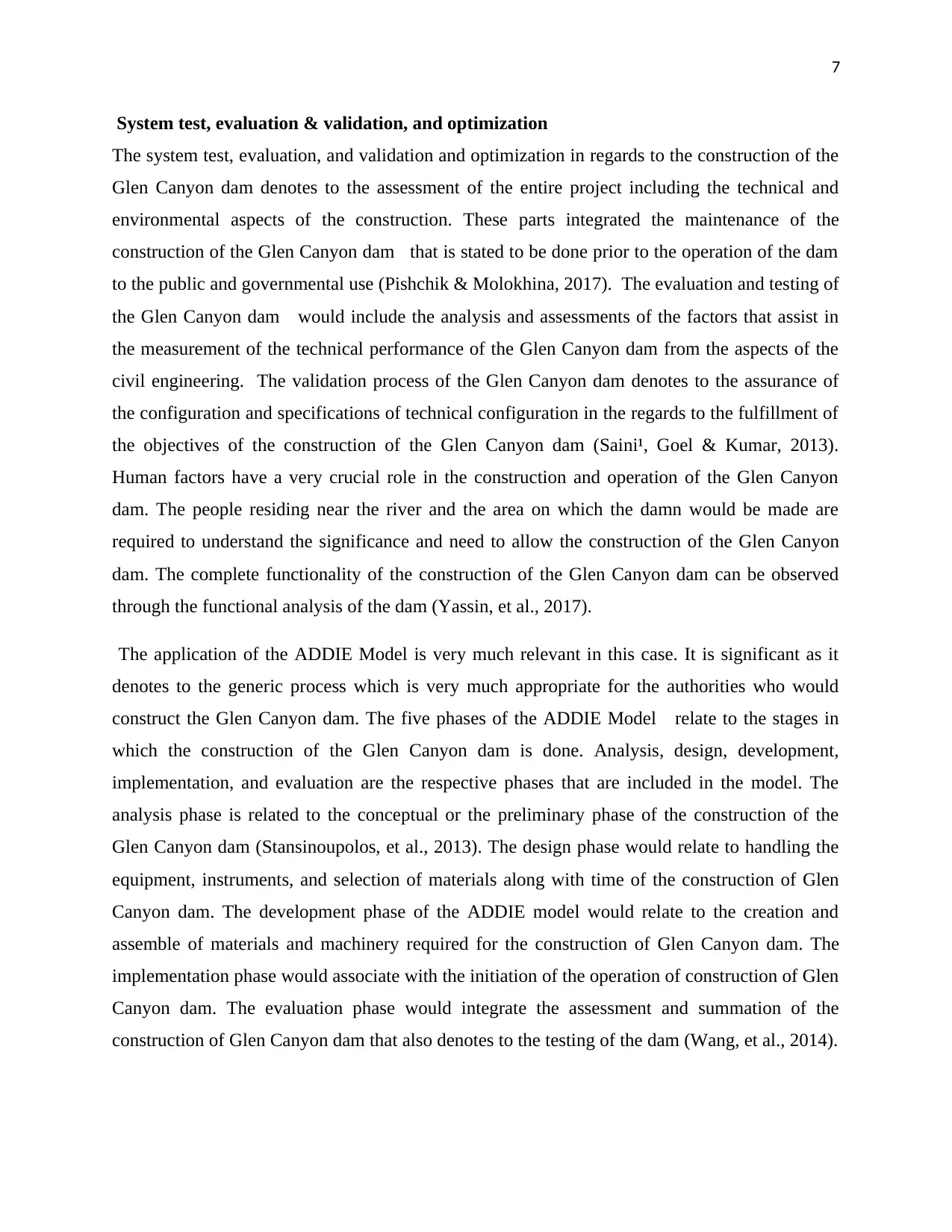
7
System test, evaluation & validation, and optimization
The system test, evaluation, and validation and optimization in regards to the construction of the
Glen Canyon dam denotes to the assessment of the entire project including the technical and
environmental aspects of the construction. These parts integrated the maintenance of the
construction of the Glen Canyon dam that is stated to be done prior to the operation of the dam
to the public and governmental use (Pishchik & Molokhina, 2017). The evaluation and testing of
the Glen Canyon dam would include the analysis and assessments of the factors that assist in
the measurement of the technical performance of the Glen Canyon dam from the aspects of the
civil engineering. The validation process of the Glen Canyon dam denotes to the assurance of
the configuration and specifications of technical configuration in the regards to the fulfillment of
the objectives of the construction of the Glen Canyon dam (Saini¹, Goel & Kumar, 2013).
Human factors have a very crucial role in the construction and operation of the Glen Canyon
dam. The people residing near the river and the area on which the damn would be made are
required to understand the significance and need to allow the construction of the Glen Canyon
dam. The complete functionality of the construction of the Glen Canyon dam can be observed
through the functional analysis of the dam (Yassin, et al., 2017).
The application of the ADDIE Model is very much relevant in this case. It is significant as it
denotes to the generic process which is very much appropriate for the authorities who would
construct the Glen Canyon dam. The five phases of the ADDIE Model relate to the stages in
which the construction of the Glen Canyon dam is done. Analysis, design, development,
implementation, and evaluation are the respective phases that are included in the model. The
analysis phase is related to the conceptual or the preliminary phase of the construction of the
Glen Canyon dam (Stansinoupolos, et al., 2013). The design phase would relate to handling the
equipment, instruments, and selection of materials along with time of the construction of Glen
Canyon dam. The development phase of the ADDIE model would relate to the creation and
assemble of materials and machinery required for the construction of Glen Canyon dam. The
implementation phase would associate with the initiation of the operation of construction of Glen
Canyon dam. The evaluation phase would integrate the assessment and summation of the
construction of Glen Canyon dam that also denotes to the testing of the dam (Wang, et al., 2014).
System test, evaluation & validation, and optimization
The system test, evaluation, and validation and optimization in regards to the construction of the
Glen Canyon dam denotes to the assessment of the entire project including the technical and
environmental aspects of the construction. These parts integrated the maintenance of the
construction of the Glen Canyon dam that is stated to be done prior to the operation of the dam
to the public and governmental use (Pishchik & Molokhina, 2017). The evaluation and testing of
the Glen Canyon dam would include the analysis and assessments of the factors that assist in
the measurement of the technical performance of the Glen Canyon dam from the aspects of the
civil engineering. The validation process of the Glen Canyon dam denotes to the assurance of
the configuration and specifications of technical configuration in the regards to the fulfillment of
the objectives of the construction of the Glen Canyon dam (Saini¹, Goel & Kumar, 2013).
Human factors have a very crucial role in the construction and operation of the Glen Canyon
dam. The people residing near the river and the area on which the damn would be made are
required to understand the significance and need to allow the construction of the Glen Canyon
dam. The complete functionality of the construction of the Glen Canyon dam can be observed
through the functional analysis of the dam (Yassin, et al., 2017).
The application of the ADDIE Model is very much relevant in this case. It is significant as it
denotes to the generic process which is very much appropriate for the authorities who would
construct the Glen Canyon dam. The five phases of the ADDIE Model relate to the stages in
which the construction of the Glen Canyon dam is done. Analysis, design, development,
implementation, and evaluation are the respective phases that are included in the model. The
analysis phase is related to the conceptual or the preliminary phase of the construction of the
Glen Canyon dam (Stansinoupolos, et al., 2013). The design phase would relate to handling the
equipment, instruments, and selection of materials along with time of the construction of Glen
Canyon dam. The development phase of the ADDIE model would relate to the creation and
assemble of materials and machinery required for the construction of Glen Canyon dam. The
implementation phase would associate with the initiation of the operation of construction of Glen
Canyon dam. The evaluation phase would integrate the assessment and summation of the
construction of Glen Canyon dam that also denotes to the testing of the dam (Wang, et al., 2014).
Paraphrase This Document
Need a fresh take? Get an instant paraphrase of this document with our AI Paraphraser
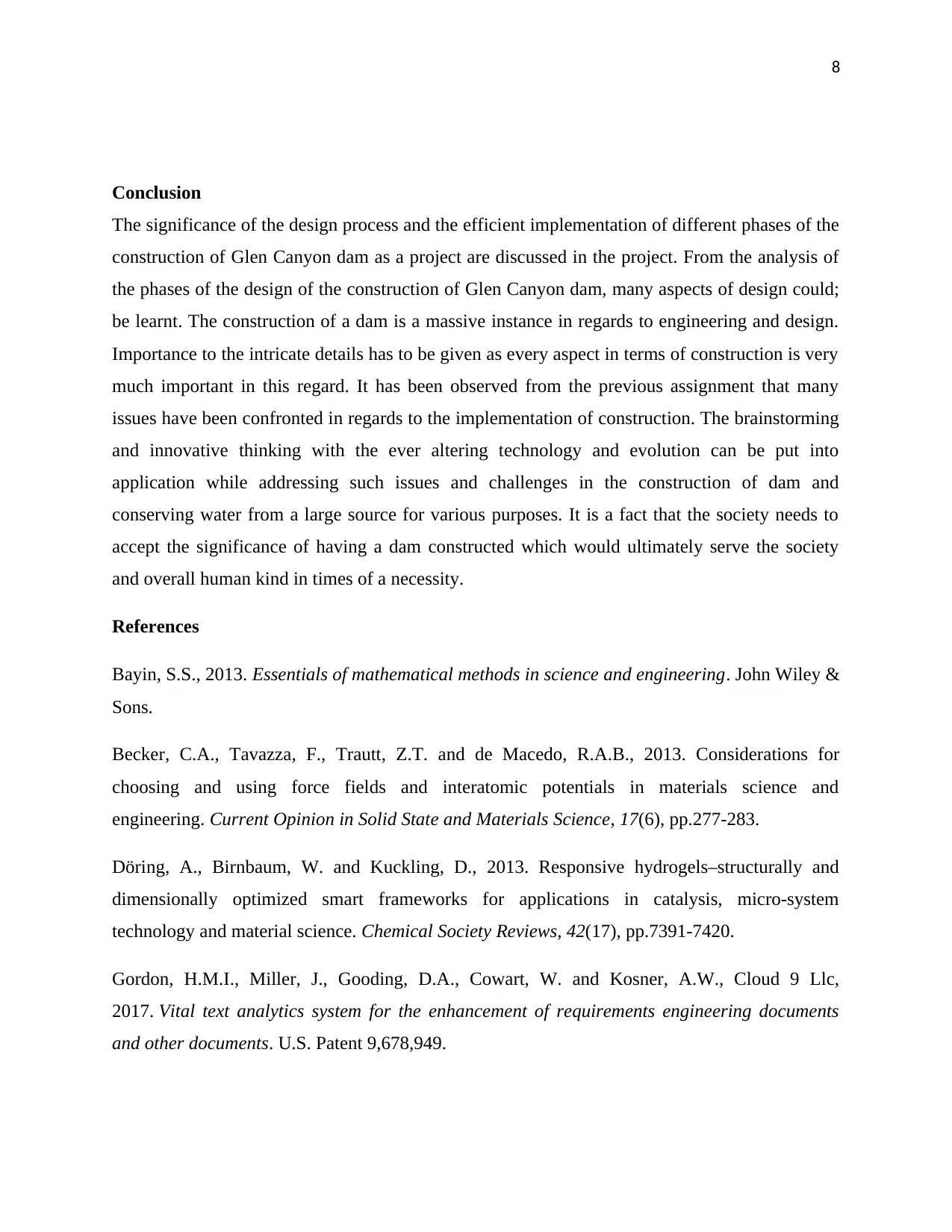
8
Conclusion
The significance of the design process and the efficient implementation of different phases of the
construction of Glen Canyon dam as a project are discussed in the project. From the analysis of
the phases of the design of the construction of Glen Canyon dam, many aspects of design could;
be learnt. The construction of a dam is a massive instance in regards to engineering and design.
Importance to the intricate details has to be given as every aspect in terms of construction is very
much important in this regard. It has been observed from the previous assignment that many
issues have been confronted in regards to the implementation of construction. The brainstorming
and innovative thinking with the ever altering technology and evolution can be put into
application while addressing such issues and challenges in the construction of dam and
conserving water from a large source for various purposes. It is a fact that the society needs to
accept the significance of having a dam constructed which would ultimately serve the society
and overall human kind in times of a necessity.
References
Bayin, S.S., 2013. Essentials of mathematical methods in science and engineering. John Wiley &
Sons.
Becker, C.A., Tavazza, F., Trautt, Z.T. and de Macedo, R.A.B., 2013. Considerations for
choosing and using force fields and interatomic potentials in materials science and
engineering. Current Opinion in Solid State and Materials Science, 17(6), pp.277-283.
Döring, A., Birnbaum, W. and Kuckling, D., 2013. Responsive hydrogels–structurally and
dimensionally optimized smart frameworks for applications in catalysis, micro-system
technology and material science. Chemical Society Reviews, 42(17), pp.7391-7420.
Gordon, H.M.I., Miller, J., Gooding, D.A., Cowart, W. and Kosner, A.W., Cloud 9 Llc,
2017. Vital text analytics system for the enhancement of requirements engineering documents
and other documents. U.S. Patent 9,678,949.
Conclusion
The significance of the design process and the efficient implementation of different phases of the
construction of Glen Canyon dam as a project are discussed in the project. From the analysis of
the phases of the design of the construction of Glen Canyon dam, many aspects of design could;
be learnt. The construction of a dam is a massive instance in regards to engineering and design.
Importance to the intricate details has to be given as every aspect in terms of construction is very
much important in this regard. It has been observed from the previous assignment that many
issues have been confronted in regards to the implementation of construction. The brainstorming
and innovative thinking with the ever altering technology and evolution can be put into
application while addressing such issues and challenges in the construction of dam and
conserving water from a large source for various purposes. It is a fact that the society needs to
accept the significance of having a dam constructed which would ultimately serve the society
and overall human kind in times of a necessity.
References
Bayin, S.S., 2013. Essentials of mathematical methods in science and engineering. John Wiley &
Sons.
Becker, C.A., Tavazza, F., Trautt, Z.T. and de Macedo, R.A.B., 2013. Considerations for
choosing and using force fields and interatomic potentials in materials science and
engineering. Current Opinion in Solid State and Materials Science, 17(6), pp.277-283.
Döring, A., Birnbaum, W. and Kuckling, D., 2013. Responsive hydrogels–structurally and
dimensionally optimized smart frameworks for applications in catalysis, micro-system
technology and material science. Chemical Society Reviews, 42(17), pp.7391-7420.
Gordon, H.M.I., Miller, J., Gooding, D.A., Cowart, W. and Kosner, A.W., Cloud 9 Llc,
2017. Vital text analytics system for the enhancement of requirements engineering documents
and other documents. U.S. Patent 9,678,949.
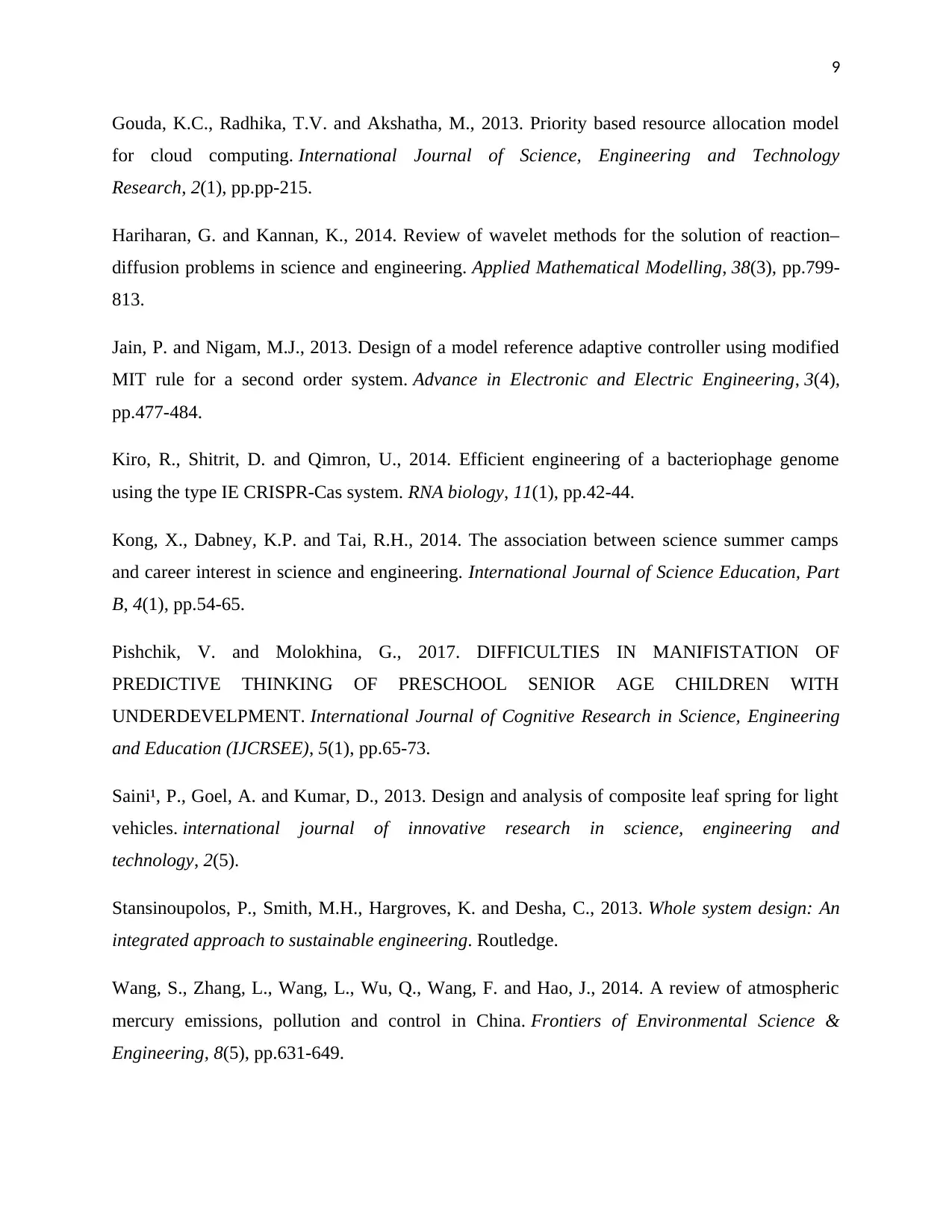
9
Gouda, K.C., Radhika, T.V. and Akshatha, M., 2013. Priority based resource allocation model
for cloud computing. International Journal of Science, Engineering and Technology
Research, 2(1), pp.pp-215.
Hariharan, G. and Kannan, K., 2014. Review of wavelet methods for the solution of reaction–
diffusion problems in science and engineering. Applied Mathematical Modelling, 38(3), pp.799-
813.
Jain, P. and Nigam, M.J., 2013. Design of a model reference adaptive controller using modified
MIT rule for a second order system. Advance in Electronic and Electric Engineering, 3(4),
pp.477-484.
Kiro, R., Shitrit, D. and Qimron, U., 2014. Efficient engineering of a bacteriophage genome
using the type IE CRISPR-Cas system. RNA biology, 11(1), pp.42-44.
Kong, X., Dabney, K.P. and Tai, R.H., 2014. The association between science summer camps
and career interest in science and engineering. International Journal of Science Education, Part
B, 4(1), pp.54-65.
Pishchik, V. and Molokhina, G., 2017. DIFFICULTIES IN MANIFISTATION OF
PREDICTIVE THINKING OF PRESCHOOL SENIOR AGE CHILDREN WITH
UNDERDEVELPMENT. International Journal of Cognitive Research in Science, Engineering
and Education (IJCRSEE), 5(1), pp.65-73.
Saini¹, P., Goel, A. and Kumar, D., 2013. Design and analysis of composite leaf spring for light
vehicles. international journal of innovative research in science, engineering and
technology, 2(5).
Stansinoupolos, P., Smith, M.H., Hargroves, K. and Desha, C., 2013. Whole system design: An
integrated approach to sustainable engineering. Routledge.
Wang, S., Zhang, L., Wang, L., Wu, Q., Wang, F. and Hao, J., 2014. A review of atmospheric
mercury emissions, pollution and control in China. Frontiers of Environmental Science &
Engineering, 8(5), pp.631-649.
Gouda, K.C., Radhika, T.V. and Akshatha, M., 2013. Priority based resource allocation model
for cloud computing. International Journal of Science, Engineering and Technology
Research, 2(1), pp.pp-215.
Hariharan, G. and Kannan, K., 2014. Review of wavelet methods for the solution of reaction–
diffusion problems in science and engineering. Applied Mathematical Modelling, 38(3), pp.799-
813.
Jain, P. and Nigam, M.J., 2013. Design of a model reference adaptive controller using modified
MIT rule for a second order system. Advance in Electronic and Electric Engineering, 3(4),
pp.477-484.
Kiro, R., Shitrit, D. and Qimron, U., 2014. Efficient engineering of a bacteriophage genome
using the type IE CRISPR-Cas system. RNA biology, 11(1), pp.42-44.
Kong, X., Dabney, K.P. and Tai, R.H., 2014. The association between science summer camps
and career interest in science and engineering. International Journal of Science Education, Part
B, 4(1), pp.54-65.
Pishchik, V. and Molokhina, G., 2017. DIFFICULTIES IN MANIFISTATION OF
PREDICTIVE THINKING OF PRESCHOOL SENIOR AGE CHILDREN WITH
UNDERDEVELPMENT. International Journal of Cognitive Research in Science, Engineering
and Education (IJCRSEE), 5(1), pp.65-73.
Saini¹, P., Goel, A. and Kumar, D., 2013. Design and analysis of composite leaf spring for light
vehicles. international journal of innovative research in science, engineering and
technology, 2(5).
Stansinoupolos, P., Smith, M.H., Hargroves, K. and Desha, C., 2013. Whole system design: An
integrated approach to sustainable engineering. Routledge.
Wang, S., Zhang, L., Wang, L., Wu, Q., Wang, F. and Hao, J., 2014. A review of atmospheric
mercury emissions, pollution and control in China. Frontiers of Environmental Science &
Engineering, 8(5), pp.631-649.
⊘ This is a preview!⊘
Do you want full access?
Subscribe today to unlock all pages.

Trusted by 1+ million students worldwide

10
Yassin, I.M., Jailani, R., Ali, M., Baharom, R., Hassan, A. and Rizman, Z.I., 2017. Comparison
between cascade forward and multi-layer perceptron neural networks for NARX functional
electrical stimulation (FES)-based muscle model. International Journal on Advanced Science,
Engineering and Information Technology, 7(1), pp.215-221.
Yassin, I.M., Jailani, R., Ali, M., Baharom, R., Hassan, A. and Rizman, Z.I., 2017. Comparison
between cascade forward and multi-layer perceptron neural networks for NARX functional
electrical stimulation (FES)-based muscle model. International Journal on Advanced Science,
Engineering and Information Technology, 7(1), pp.215-221.
1 out of 10
Related Documents
Your All-in-One AI-Powered Toolkit for Academic Success.
+13062052269
info@desklib.com
Available 24*7 on WhatsApp / Email
![[object Object]](/_next/static/media/star-bottom.7253800d.svg)
Unlock your academic potential
Copyright © 2020–2025 A2Z Services. All Rights Reserved. Developed and managed by ZUCOL.




